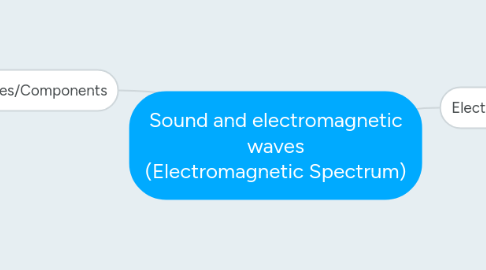
1. Types/Components
1.1. Radiowaves
1.1.1. Longest wavelength and smallest electromagnetic wave ( not on colour spectrum) Wavelength (m) > 1 x 10-1 Frequency (Hz) < 3 x 109 Energy (J) < 2 x 10-24
1.1.2. Used for entertainment such as FM Radio waves - 53-171kHz with FM
1.1.3. Used for remote controlled toys- 1-80 MHz
1.2. Microwaves
1.2.1. Wavelength (m) 1 x 10-3 - 1 x 10-1 Frequency (Hz) 3 x 109 - 3 x 1011 Energy ( J) 2 x 10-24- 2 x 10-22
1.2.2. Mode of action
1.2.2.1. Causes molecules to rotate as the molecules want to rotate to align with the incoming magnetic field, increasing the energy level of the molecules and producing heat
1.2.2.2. Used in microwave ovens, television satellites and dishes (radar devices)
1.3. Infra-red waves
1.3.1. Wavelength 10−5 meters Frequency 4 x 1014 Hertz Energy 10−1 Electron Volts
1.3.2. All objects above the temperature of absolute zero (-273°C) emit infra-red radiation. In other words all warm objects give off infra-red rays. Infra-red radiations cannot be seen by the human eye but their effects can be sense by the skin as warmth.
1.3.3. Thermal imaging cameras make use of infra-red radiations emitted from objects to form an image. These are used by firemen to detect people where visibility is severely reduced by smoke. Infrared waves are also used as a source for carrier signals in fibre optics. Burglar alarms use sensors which detect the infra-red rays given off by intruders.
1.4. Visible Light
1.4.1. Wavelength 10−7 meters Frequency 7.5 x 1014 Hertz Energy 101 Electron Volts
1.4.2. This is the small part of the electromagnetic spectrum that is detectable by the human eye. All objects with enough heat to glow emit light waves. The sun is the main source of light. Light bulbs work on the heating effect caused by electrical resistance in a filament lamp to cause it to glow and emit light. White light is made up of a mixture of colours. This spectrum of colours making up white light can be viewed when light is dispersed such as in a rainbow. The colours, in order are: red, orange, yellow, green, blue, indigo and violet.
1.4.3. Used in optic fibers for medical uses and telecommunications
1.5. Ultraviolet
1.5.1. Wavelength 10−8 meters Frequency 1016 Hertz Energy 102 Electron Volts
1.5.2. Causes the skin or to burn, and produce vitamin D in the human body which is contributed to good health
1.5.3. Ultra-violet sterilizer for a Koi Pond to kill micro-organisms in water. UV disinfection used in hospitals and water purifications
1.5.4. X ray
1.5.4.1. Wavelength 10−10 meters Frequency 1018 Hertz Energy 105 Electron Volts
1.5.4.2. X-rays are produced from the collision of high speed electrons with metals. With a high frequency and small wavelength the high energy photons associated with X-rays enables them to penetrate most materials. X-rays are also ionising radiations which makes them dangerous as they can cause biological changes in living cells.
1.5.4.3. X-rays are mainly used in the field of medicine. They are used to produce images of bones and teeth vital for diagnosis and treatment. Where the x-rays find it difficult to penetrate such as bones or teeth shown up as lighter areas on the film. X-rays are also used in airports to check baggage and in industry as a quality control tool for e.g. to check packaged food do not contain metal or stones
1.6. Gamma
1.6.1. Wavelength 10−12 meters Frequency 1020 Hertz Energy 107 Electron Volts
1.6.2. Gamma rays have the smallest wavelength and their photons have the most energy of all the waves in the electromagnetic spectrum. They are generated by the decay of radioactive atoms and nuclear explosions. The high energy of gamma ray photons means they can pass through most things. Gamma rays are a form of ionising radiation, which means that when they pass through matter they pass on their energy to electrons in the atoms they hit. This makes them dangerous as they can ionise atoms in the body thereby damaging and killing cells. If the DNA in a cell is damaged by gamma radiation it can mutate and cause cancer.
1.6.3. The ionising nature of gamma rays has been used by medicine to its advantage. By carefully directing and controlling a beam of gamma radiation onto cancer cells they can be destroyed and their development controlled. Gamma rays are used to sterilise food and hospital equipment. Gamma rays kill bacteria and mould in food prolonging its shelf life.

